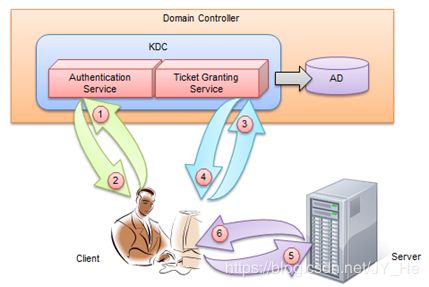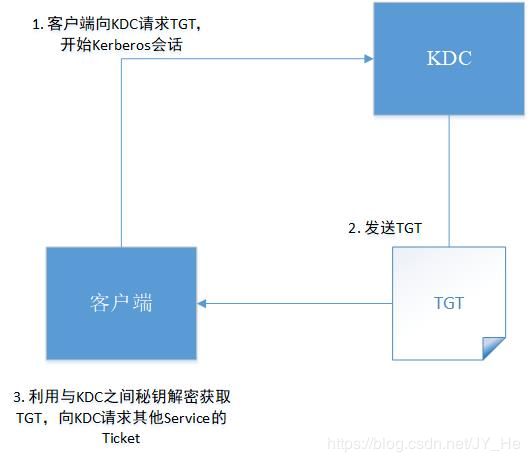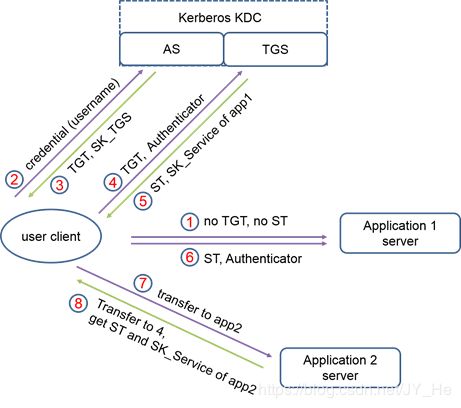Keberos安全认证学习
因为,最近要做大数据组件的安全认证,需要涉及到kerberos这个组件,记录相关资料,后续查看。
Kerberos 是一种网络认证协议,它采用了传统的共享密钥的方式,实现了在网络环境不一定保证安全的环境下,client和server之间的通信,适用于client/server模型。用户只需输入一次身份验证信息,就可凭借此验证获得的票据授予票据(ticket-granting ticket)访问多个接入Kerberos的服务。
图 1.1 Kerberos认证
Kerberos角色概念:
- AS(Authentication Server):认证服务器。KDC的一部分。通常会维护一个包含安全个体及其秘钥的数据库,用于身份认证
- KDC(Key Distribution Center):密钥分发中心。,是一个提供票据(tickets)和临时会话密钥(session keys)的网络服务。KDC服务作为客户端和服务器端信赖的第三方,为其提供初始票据(initial ticket)服务和票据授予票据(ticket-granting ticket)服务,前半部分有时被称为AS,后半部分有时则被称为TGS。
- TGT(Ticket Granting Ticket):票据授权票据,票据的票据。包含客户端ID、客户端网络地址、票据有效期以及client/TGS会话密钥(TGT是和Server无关的)
- TGS(Ticket Granting Server):票据授权服务器。KDC的一部分,根据客户端传来的TGT发放访问对应服务的票据
- SS(Service Server):特定服务提供端
- Principal:被认证的个体。(client principal/server principal: 分别表示客户端和服务器的名字,命名规则:主名称+实例+领域。例如:admin/[email protected])
- Ticket:票据,客户端用它访问对应服务。包含:用户名,IP,时间戳,有效期,会话秘钥
- Session key:会话密钥,指两个安全个体之间使用的临时加密秘钥,其时效性取决于单点登录的会话时间长短
- Keytab:以文件的形式呈现,存储了一个或多个Principal的长期的key。用途和密码类似,用于kerberos认证登录(让用户不需要明文的存储密码,和程序交互时不需要人为交互来输入密码)
认证过程
开启安全认证后的认证方式有两种:
- 使用密码认证:
使用用户密码通过kinit认证, 获取到的TGT存在本地凭证缓存当中, 供后续访问服务认证使用。一般在交互式访问中使用。
- 使用 keytab 认证:
用户通过导出的keytab 可以免密码进行用户认证, 后续步骤一致。一般在应用程序中配置使用。
Kerberos的认证过程可细分为三个阶段:初始验证、获取服务票据和服务验证:
第一阶段主要是客户端向KDC中的AS发送用户信息,以及请求TGT。
- 客户端向KDC发送自己身份,即提供用户名密码(避免频繁使用用户名密码,可以使用keytab这个密码本);
- AS收到请求后,随机生成一个密码Session Key,简称为SK1(使用客户端的Master Key和自己的Master Key进行加密),并返回给客户端两条消息:a)一个给客户端,b)另一个给TGS
- 客户端通过自己的Master Key对第一部分进行解密获得SK1之后,以及TGS的密钥加密的TGT 。
TGT大体又包含以下的内容:
- SK1:只在一段时间内有效的Short-term Key
- End time: TGT到期的时间。
- Client name & realm: 简单地说就是Domain name\Client;
1.2初始验证流程图
第二阶段客户端拿到之前获得的TGT(一个TGT可以从KDC获得基于不同Server的Ticket)向KDC中的TGS请求访问某个服务的票据。
- 客户端在获得自己和KDC的SK1之后,生成自己的A uthentication以及要访问的Server名称,并使用Session Key进行加密,连同TGT一同发送给KDC;
- KDC中的TGS首先检查KDC数据库中是否存在所需服务,若存在则使用自己的Master Key对TGT进行解密,提取客户端信息(Client Info)和SK1,然后,使用这个SK1解密Authenticator获得Client Info,对两个Client Info进行对比,进行身份验证。
- 若验证通过,TGS则使用SK1对客户端和服务端的会话密钥进行加密,该会话秘钥是KDC新生成的随机密钥,用于客户端与服务端的通信加密,这里简称KS2;
- 使用服务端的密钥加密客户端访问服务端的票据(Ticket,包含用户ID、用户网络地址、票据有效期和SK2),之所以使用服务端的密钥加密,因为该Ticket是给服务验证的,且需要经过客户端传给服务端,且不能让客户端看到;
- 客户端收到消息后,尝试通过SK1解密KDS发送的消息,得到客户端和服务端的会话密钥SK2。
注意:这里KDC不直接发送给服务的主要原因是:怕网络延迟的场景下,KDC同时将消息发送给客户端和服务端,无法确保同时到达服务端,在极端情况下KDC与服务端网络临时不通,导致客户端访问客户端验证失败,而实际上客户端是具有访问服务端权限的。
第三阶段拿到票据(Ticket)后再到该服务的提供端验证身份,然后使用建立的加密通过和服务通信。
- 客户端向服务端发送两条消息:1)客户端-服务端票据;2)通过SK2加密的会话密钥(Authenticator,包含用户ID和时间戳);
- 服务端收到消息后,尝试用自己的密钥解密第一条消息,即客户端对服务端进行验证(真正拥有正确密钥的服务端才能正确解密,从Ticket中获取SK2),然后再用SK2解密第二条消息,和TGS一样,对分别来自Ticket和Authenticator中的用户ID进行验证,如果验证通过则返回确认消息,并且用SK2加密新时间戳;
- 客户端尝试用SK2解密时间戳,得到新时间戳验证其正确性,通过验证客户端与服务端就达到了信任。(后续的通信都采用SK2加密,就好客户端与服务端比建立一个加密通道)
图1.3 获取服务票据和服务验证流程图
对于TGT和Ticket给出了巧妙的比喻:TGT类似于护照,Ticket则是签证,而访问特定的服务则好比出游某个国家。与护照一样,TGT可标识你的身份并允许你获得多个Ticket(签证),每个Ticket对应一个特定的服务,TGT和Ticket同样具有有效期,过期后就需要重新认证。
其中,TGT具有有效期,如果过期就会失效,此后Client不得不重新向KDC申请新的TGT,KDC将会生成一个不同Session Key和与之关联的TGT。整个认证流程图如下图所示:
图1.4 Kerberos认证流程
Hadoop安全机制
Hadoop在1.0.0版本之后引入Kerberos认证机制,即用户跟服务通信以及各个服务之间通信均用Kerberos认证,在用户认证后任务执行、访问服务、读写数据等均采用特定服务发起访问token,让需求方凭借token访问相应服务和数据:
- 用户先向KDC请求TGT,做初始验证;
- 用户通过TGT向KDC请求访问服务的Ticket;
- 客户端通过ticket向服务认证自己,完成身份认证;
- 完成身份认证后,客户端向服务请求若干token供后续任务执行时认证使用;
- 后续任务执行使用token与服务进行认证
这里,Delegation Token是Hadoop自身实现的一种轻量级认证机制(Kerberos是三方认证协议,而Delegation Tokens只涉及到两方。)为了避免所有任务都要需要使用TGT通过Kerberos来进行认证,对KDC造成网络拥塞,系统瓶颈。当然,Delegation Token也具有有效期,需要周期性的更新以保证其有效性。考虑到高可用性,Delegation Tokens会被server进行持久化。HDFS NameNode将Delegation Tokens持久化到元数据中。
Server和Client在处理Delegation Tokens时会有不同的职责:
server端的Delegation Tokens
- 发布Delegation Tokens,并保存用以验证;
- 响应更新Delegation Tokens请求;
- 当client端执行删除操作或token过期时,移除token;
- 通过验证client提供的Tokens和Server端存储的token是否一致,来对client进行认证
Hadoop中Delegation Tokens的生成和验证主要依赖于HMAC机制。Delegation Token主要由两部分组成:public部分和private部分,并以
- public部分信息用于token识别,以identifier对象形式存在,作为key;
- private部分由DelegationTokenInformation类来表示,作为value。
server端可以配置更新周期(renew-interval,默认24小时),以及Delegation Token的过期时间。过期的Delegation Tokens不能用于认证,且server端专门有一个后台线程用于将过期token移除。
server token的public部分和private部分主要包含如下表所示:
| Kind |
The kind of token (HDFS_DELEGATION_TOKEN, or kms-dt). The token also contains the kind, matching the identifier’s kind. |
| Owner |
The user who owns the token. |
| Renewer |
The user who can renew the token |
| Real User |
Only relevant if the owner is impersonated. If the token is created by an impersonating user, this will identify the impersonating user. |
| Issue Date |
Epoch time when the token was issued |
| Max Date |
Epoch time when the token can be renewed until |
| Sequence Number |
UUID to identify the token |
| Master Key ID |
ID of the master key used to create and verify the token |
表1 server token public部分组成内容
| renewDate |
Epoch time when the token is expected to be renewed. |
| password |
The password calculated as HMAC of Token Identifier using master key as the HMAC key. |
| trackingId |
A tracking identifier that can be used to associate usages of a token across multiple client sessions. |
表2 server token private部分组成内容
client端的Delegation tokens
- 从server端请求一个新的Delegation Tokens,请求同时可以指定token的更新者(renewer);
- 更新Delegation Tokens(如果client将自己指定为renewer),亦或请求别的组件更新token(指定的renewer)
- 向server发送取消Delegation Tokens的请求
- 提供Delegation Tokens供server进行认证;
client token包含以下内容:
| identifier |
The token identifier matching the public information part at the server side. |
| password |
The password matching the password at the server side. |
| kind |
The kind of token (e.g. HDFS_DELEGATION_TOKEN, or kms-dt), it matches the identifier’s kind. |
| service |
The name of the service (e.g. ha-hdfs: |
| renewer |
The user who can renew the token (e.g. yarn). |
Kerberos ticket 生命周期
Kerberos ticket 有两种生命周期,ticket lifetime (票据生命周期) 和 renewable lifetime (可再生周期)。
- 当ticket lifetime结束时,该ticket将不再可用;
- 如果renewable lifetime>ticket lifetime,那么在票据生命周期内都可以对其进行续约,直到达到可再生周期上限;
- 当时间达到renewable lifetime后,ticket lifetime结束后将不能继续续期,续期时将会报错”KDC can't fulfill requested option while renewing credentials”,之后需要重新申请新的ticket;
- 可再生周期与keytab无关,如果没有key和principle,keytab内容不会改变。
客户端配置项:krb5.conf
- ticket_lifetime = 1d -- ticket 的生命周期
- renew_lifetime = 7d --设置可续约的时长
1. 在登录后的一天后可以对ticket进行续期,直到第一次登录的7天后将不再允许续约;
2. 在一天内没有进行续期,将无法进行续期;
3. 对ticket进行一次续期后,ticket_lifetime恢复到24h
服务端配置项:kdc.conf
- max_life -- ticket 的默认生命周期,默认为 24h
- max_renewable_life -- ticket 允许被 renew 的最长时期,默认为0
kdc.conf配置的更改对新建的principal会立即生效,旧的不会生效,如果需要对旧的principal生效,需要modprinc指令修改:
modprinc -maxlife 670s -maxrenewlife 700s admin/[email protected]
Hadoop token生命周期
Hadoop token生命周期配置在hdfs-site.xml文件中:
| 配置项 |
默认值 |
|
| dfs.namenode.delegation.key.update-interval |
86400000 |
The update interval for master key for delegation tokens in the namenode in milliseconds. |
| dfs.namenode.delegation.token.max-lifetime |
604800000 |
The maximum lifetime in milliseconds for which a delegation token is valid |
| dfs.namenode.delegation.token.renew-interval |
86400000 |
The renewal interval for delegation token in milliseconds |
凭证过期处理策略
当凭证过期之后,对安全认证的服务的后续访问则会失败。有两种方式可以解决凭证过期的问题:
- 扩大 ticket_lifetime 和 renew_lifetime 时限;
- 定期重新进行kinit 认证更新凭证。
Hadoop 将 Kerberos 认证部分进行了一定的封装到 UserGroupInformation 这个类。
UserGroupInformation 在 JAAS 框架上封装了 Hadoop 的用户信息, 更确切地说是对 Subject 做了一层封装。JAAS 是 Java 认证和授权服务(Java Authentication and Authorization Service)的缩写, 主要包含以下几个实体:
- Subject
Subject 是一个不可继承的实体类,它标志一个请求的来源, 包含相关的凭证标识(Principal) 和 公开和私有的凭据(Credential)。
- Principal
凭证标识,认证成功后,一个 Subject 可以被关联多个Principal。
- Credential
凭据,有公有凭据以及私有凭据
JAAS认证依赖LoginContext,客户端通过一个LoginContext对象与JAAS相互作用,这个LoginContext对象提供了一种开发应用程序的方式,它不依赖于底层的认证技术,主要描述了用于验证对象(subjects)的方法。
在安全模式下,UGI 支持不同LoginContext 配置,均是通过 HadoopConfiguration 类动态产生:
1)hadoop-user-kerberos
使用kerberos缓存凭证登陆的配置, useTicketCache 置为 true
2)hadoop-keytab-kerberos
使用keytab登陆的配置, useKeyTab 置为 true
免于每次输入密码,采用基于keytab 的Kerberos认证方式,调用 loginUserFromKeytab方法 完成登录,后续可以定时执行:
UserGroupInformation.getLoginUser().reloginFromKeytab()尝试重新登录。
参考链接:
https://blog.csdn.net/wenwen360360/article/details/78913347
https://ieevee.com/tech/2016/06/07/kerberos-1.html
https://www.cnblogs.com/wuyuxiang/p/5166677.html
https://blog.csdn.net/lovebomei/article/details/79807484
https://blog.csdn.net/co_zjw/article/details/81974845
https://blog.cloudera.com/blog/2017/12/hadoop-delegation-tokens-explained/#4
https://www.cnblogs.com/zhzhang/p/5692249.html



